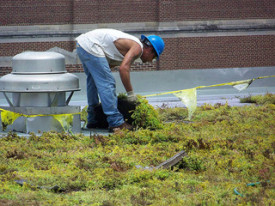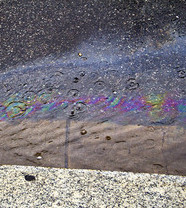Remember the Puget Sound stormwater permits? Washington state was ready at last to get serious about cleaning up polluted runoff through the use of rain gardens, permeable pavement, and other green strategies. The new rules went into effect in August, but were socked with a downpour of legal challenges.
So while cities and counties are working to meet the new regulations, a mist of uncertainty hangs over the process. But that could be cleared up soon.
The Pollution Control Hearings Board, the legal entity weighing the challenges, announced it will rule on the case before the end of February.
The stormwater permits attack the problem of polluted runoff from multiple angles. One of the more controversial provisions is a requirement that larger governments update their building codes to make green technologies the preferred approach to handling stormwater on development and construction projects. Additional rules address pollution monitoring and require environmental assessments for large swaths of land called “watersheds.” (My Sightline colleagues did a fantastic job summarizing the new rules for Western Washington cities and counties both large and small.)
In October the board issued a bunch of summary judgments, many in favor of the state Department of Ecology, which wrote the permits, and the environmental groups backing Ecology. In the past, green groups have challenged the regulations for being too lenient, but the organizations came out in support of the new rules.
“We did think they could have been a lot better, but they still represent an important step forward,” said Jan Hasselman, an EarthJustice attorney representing environmental interests in this case, in a recent interview.
Opponents to the stormwater permits have lots of objections, including the arguments that they require the use of unproven technologies and amount to illegal regulations on how land can be developed. The opposition calls parts of the permits “unlawful, unjust, impracticable, or otherwise unreasonable.”
The board ruled on some of these points in the fall, saying it’s not so:
“The conditions (of the permits)…are designed to address pollution, not to control the use of land.”
This isn’t the first time the Pollution Control Hearings Board has considered the legality of the stormwater permits.

Installing a green roof at the University of Michigan, photo from Flickr’s Cory Seeman, Creative Commons.
Ecology is designated by the Environmental Protection Agency to uphold the federal Clean Water Act, and that includes curbing the oily, metal-tinged, dirty mess that flows from roofs and roads into the nation’s rivers, lakes, and marine waters. One of its tools for stemming the stormwater tide is through municipal stormwater permits, also called National Pollution Discharge Elimination System (NPDES) permits.
The permits apply to the Puget Sound area’s cities and counties. Larger permittees––Seattle, Tacoma, and King and Snohomish counties, for example––are part of the Phase I group, which gets tougher regulations sooner. The Phase II group includes 80 medium and small cities and the urban portion of four counties; those rules are less stringent and kick in more slowly.
The current rules were finalized in 2012 and took effect August 1, 2013. Before that, the local governments were regulated by permits dating from 2007 that were also appealed in court. Back then, both the enviro community and the cities and counties blasted the rules, one side arguing the permits didn’t do enough to safeguard waterways while the other alleged that the regulations went too far.
In the decisions issued this fall, the board went back to those previous challenges just to remind everyone where they’re starting from. And frankly, those earlier rulings have a lot of nice things to say about green stormwater solutions. (Find the October 2013 rulings on the board’s decision page by searching for case numbers 12-093c and 12-097c.)
Basically, the board already is convinced that green strategies for capturing rainwater and assisting it in soaking into the ground where it falls are effective, proven, and affordable technologies for controlling runoff.
And they think stormwater matters.
Over the years, factories and sewage treatment plants have installed better equipment and processes to their facilities so they release cleaner waste water into Puget Sound, Lake Washington and other waterways. In the meantime, more roads, parking lots, and rooftops have replaced forest and farmland. Now the biggest threat to the health of the sound and lakes is the polluted runoff that rushes untreated from hard surfaces into gutters that drain into streams.
Stormwater is a problem for two reasons. First, massive volumes of runoff erode streams and rivers, flood basements, and disrupt the flow of natural waterways. Second, it scours toxic chemicals from asphalt roofs, pesticide-treated yards, and oil-dripped-on pavement and flushes them into lakes and bays. Ecology has focused on the latter threat in a series of reports estimating the sources and volumes of pollutants that poison the runoff.
In order to control that pollution, the board concluded that state and federal rules, “required greater use” of green stormwater technology, also called low-impact development. The board ruled in October:
“The requirements of the Phase I and Phase II permits are, by their nature, aimed at improving the quality of the environment and the beneficial uses of the state’s waters for the public at large.”
It seems like pretty solid ground from which to tackle the newest batch of objections coming from a long list of municipalities and private entities, including King, Pierce, Snohomish, Clark, and Cowlitz counties; Auburn, Bainbridge Island, Bremerton, Burlington, Des Moines, Everett, Kent, Issaquah, Lynnwood, Mount Vernon, Renton, and SeaTac; and the Building Industry Association of Clark County.
Those backing Ecology include Puget Soundkeeper Alliance, Washington Environmental Council, and the Rosemere Neighborhood Association.
Despite the appeals, local governments are still working on their stormwater management programs, said Ed O’Brien, a permit writer and stormwater engineer with Ecology, by email.
That work includes drafting ordinances and rules for stormwater requirements for new and redevelopment projects; maintaining their existing stormwater infrastructure; implementing public education programs; and preparing to launch stormwater monitoring programs.
An important question is how wholeheartedly the cities and counties will work towards reaching the permits’ goals of making the developed landscape behave like absorbent, undisturbed land. The rules contain enough squishy language to allow them to follow the letter, but not the intent, of the permits. Will municipalities make minimal demands on developers and city projects, or require people to protect native plants, install rain gardens, and lay permeable pavement everywhere that makes sense?
“It will be interesting to see how the permittees embrace this permit language,” Hasselman said. “It’s not very prescriptive, but it’s a very important part of the bigger picture.”
Many of the permits’ important deadlines don’t kick in for many months, even after the board makes its ruling.
The Phase I permittees have until July 1, 2015 to incorporate green stormwater principles into their local codes. Phase II permittees have until the end of 2016 to accomplish this task, and newly added permittees have an extra year to comply. Each county must submit a “watershed-scale stormwater plan” to Ecology by October 1, 2016. The roll out is gradual to give municipalities plenty of time and assistance to make the changes.
“Jurisdictions have another year-and-a-half or so to work on overhauling their codes. Some are going to do a great job, and some are going to fall short,” Hasselman said in an email message. “Starting in 2015, there’s going to be a lot of attention on the communities that are not doing enough.”
Stormwater watchers will have to stay tuned.
“This is going to go quiet for a while,” Hasselman said. “Then it’s going to be a big deal.”
Editors note: This post was updated at 10 a.m. February 11 to correct the status of the permits. While they are being challenged, they have gone into effect.









Heather Kibbey
Your article incorrectly states that the new rules are suspended while the appeals are pending. This is not the case–the municipal stormwater permits are in full effect. You may check with Ecology to confirm this.
Lisa Stiffler
Hi Heather — You are correct! I had misunderstood that they were suspended, but in fact are in effect. The post has been corrected to fix their status. Thanks for quickly alerting me to the error!
B. Bailey
Where in these rules does it say to save filtering trees or plant filtering trees and shrubs? why must they always look to manmade solutions when Nature has them right in front of our eyes? a moratorium on wetland intrusion and tree cutting would do a lot more a lot faster than cutting them all down and then installing low impact development strategies – IMO